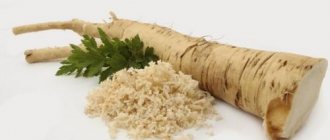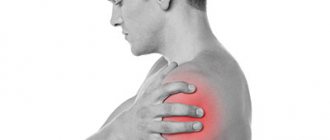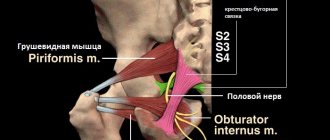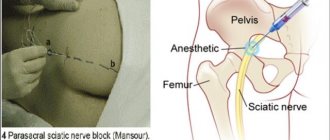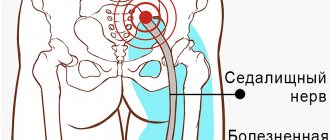What is a pinched sciatic nerve?
The sciatic nerves start from the lower back, then go through the tailbone, pelvis and legs and end at the foot. When a pinched sciatic nerve is diagnosed, the most common concern is severe pain, cutting or stabbing. Pinching occurs on one side, but sometimes bilateral damage is diagnosed. If you do not see a doctor in time, the condition may worsen. In addition to pinching, there is also inflammation of the same nerve, which manifests itself with the same symptoms. Another name for this disease is “sciatica.”
Treatment with tinctures
To completely cure inflammation of the sciatic nerve, it is necessary not only to treat with external methods, but also to treat the body itself with folk remedies, namely various tinctures, decoctions, and teas.
St. John's wort tincture
To prepare the tincture, pour boiling water over the herbs and leave for about 2 hours. Then cool and drink the drink 5 times a day for a month.
Burdock root tincture
Infusion of burdock root is good for inflammation of the sciatic nerve.
To do this, take 2 tablespoons of chopped burdock root and boil it for 5 minutes in 300 ml of red wine. The tincture should be drunk 2 times a day for 2 weeks.
Causes
Pinched sciatic nerve is caused by the following reasons:
- Intervertebral hernia. This is the main cause of the disease. Intervertebral spacers fall out, which in a healthy person prevent the vertebrae from collapsing.
- Osteochondrosis. Metabolic processes in bone tissue are disrupted, causing them to grow and affect the spinal nerves.
- Spinal injury.
- Constant hard physical labor.
- Hypothermia, especially of the back.
How to help yourself with sciatica
I’ll tell you how to relieve pain if the nerve is already pinched. Massage the acupressure points I show in the video to release stagnant energy. As soon as the energy begins to flow freely, the pain will weaken or disappear altogether. Perform the massage gently, in circular movements.
Follow simple rules (they will also help in preventing sciatica):
Move more. A sedentary lifestyle sooner or later leads to spinal pathologies. Previously, a person had about 2 thousand movements, now only 5-6 remain: we either sit, walk, or lie down. Therefore, do gymnastics, Qigong, yoga, those sports where there are many different movements.
But! If you are predisposed to sciatica, I do not recommend increased loads; it is better for a person not to lift anything heavy. Sometimes people tell me: “I can’t refuse to go to the gym, to do strength training with heavy dumbbells. I feel good during these workouts, my mood improves.”
Let me say by the way: if you really need to lift something heavy, then keep the load closer to your body. Then the load on the spine will be less.
Eat in moderation. Excess weight is also a factor that affects the development of sciatica.
Maintain a peaceful and calm spirit. This is not easy, stress lies in wait for us everywhere - but we must teach ourselves not to give in to it. Don’t overload yourself emotionally, be in nature, retire, relax. Remember that stress always tightens the muscles, and this is completely unnecessary if you are prone to sciatica.
And if possible, be sure to take a course of acupuncture. Acupuncture will not only eliminate pain and inflammation, but also put the whole body in order.
Be healthy and happy!
Symptoms
Is this really a pinched sciatic nerve, symptoms and treatment can only be determined by a neurologist
. It is this specialist that you should contact if the following symptoms appear:
- pain, for some it is not severe, for others it is quite intense, it bothers you on one side, it intensifies when sitting;
- burning and tingling in the lower part of the leg;
- when walking, the leg hurts, there is a feeling of petrification;
- the pain becomes more intense when coughing, laughing, if a person stands for a long time or sits on something hard;
- Sweating of the feet may increase, the skin turns red, and swelling occurs.
If you have a pinched sciatic nerve, the symptoms vary, depending on how severely the nerve is affected. In especially severe cases, this disease may cause the leg muscles and gluteal muscles to shrink, and it becomes difficult to move the toes or turn the foot.
What is sciatica?
The sciatic nerve is the largest nerve in the human body . It begins in the sacral nerve plexuses, arising from the 3 sacral and 2 lumbar segments of the spinal cord, and descends down the leg, branching into smaller nerves.
These branches provide energy to the foot, lower leg, thigh, knee, ankle and toes. Not surprisingly, the symptoms of sciatica depend on where the pinch is located.
Inflammation of the sciatic nerve is accompanied by pain of varying localization and intensity . The most striking sign of sciatica is pain in the lumbosacral spine, which intensifies with physical activity. It can also radiate to the thighs, buttocks, feet and legs. It is unacceptable to endure pain, as this can lead to the development of serious neurological complications.
Sciatica is an inflammation of the sciatic nerve
Causes and symptoms
Most often, sciatica occurs due to:
- lumbosacral radiculitis caused by hypothermia;
- spinal column injuries;
- inflammatory diseases of the pelvic organs - uterus, small intestine, bladder;
- osteochondrosis of the lumbosacral spine;
- herniated intervertebral discs;
- specific lesions of the spinal column (malignant neoplasms, tuberculosis).
Thus, the development of the disease can be triggered by a primary pathology of the spinal column or diseases of the internal organs. Before starting treatment for sciatica, a specialist must determine what exactly caused the inflammatory process.
Interestingly, sciatica progresses differently in different patients . Some complain of slight discomfort in the legs or back, others of severe pain that interferes with a full-fledged existence and is not relieved by painkillers. Typically, sciatica pain intensifies gradually, spreading to internal organs and large areas of the body.
Sciatica occurs in different cases with different localization of pain
Typical symptoms of sciatica are:
- numbness of the lower extremities, “wooliness”, weakness and burning in the legs;
- pain in the buttock, which spreads from the lumbar region to the feet, worsens when standing, sitting, sneezing and coughing;
- shooting pain in the leg, lower back;
- weight loss in one leg, muscle spasms, unbearable pain.
Video: “What is sciatica?”
How to treat a pinched sciatic nerve?
How to treat a pinched sciatic nerve? Treatment should be selected by a doctor after a detailed examination. You should not resort to self-medication - you can only worsen the situation. Let's talk about the main methods of treating a pinched sciatic nerve.
Massage
Massage for this disease is contraindicated, otherwise the patient’s condition may worsen. However, if the doctor recommended this procedure, you should not refuse. He or she may refer you to a specialist who specializes in these conditions. However, you should not do a massage yourself, especially before you go to a specialist.
Exercises
Exercise can help with recovery. However, if you have an acute pinched sciatic nerve, it is better to avoid them. Exercises should be performed only during the period of remission. Activities help when the load is evenly distributed on both legs, i.e. race walking or running, swimming, skiing. However, excessive loads are harmful, so running should only be light; skiing should be done leisurely. There are also special exercises, but only the attending physician should select such a complex of physical therapy. Exercise helps improve blood circulation in the legs and strengthens the muscles.
Drug treatment
If you have a pinched sciatic nerve, treatment includes taking various medications that should reduce the pain. When the disease worsens, pain-relieving injections are prescribed, which can be given intravenously, intramuscularly or into the epidural space. Local agents that improve blood circulation and relieve pain and swelling can also be used. To relax spasmodic muscles, vitamins B1 and B6 are prescribed.
Painkillers
How to cure a pinched sciatic nerve? Most often, the patient is prescribed painkillers, NSAIDs. These can be either over-the-counter medications (Aspirin, Ibuprofen, Ketoprofen) or prescription medications (Naproxan). However, it is necessary to take these medications correctly. Drinking them with food will reduce the likelihood of stomach discomfort. Otherwise, there is a high risk of developing an ulcer. Therefore, all medications must be prescribed by a specialist, strictly selecting dosages. He will also tell you how to take these medications correctly to reduce side effects.
Spa treatment
If you do not have an exacerbation, your doctor may recommend spa treatment, i.e. courses of underwater traction, mud therapy, pearl or hydrogen sulfide baths. This will not only help cope with the disease, but also strengthen the immune system, and also allow the patient to rest and recover, which is also necessary for recovery.
Yoga
Yoga can help cope with illness. Specially selected poses help relax muscles, reduce pain, and improve blood circulation. However, during periods of exacerbation, it is better to avoid yoga. Remember to warm up first, do a warm-up, and only then perform more complex exercises. It is advisable to talk with professionals who will help you choose the right set of asanas.
Electrophoresis
Doctors note that physiotherapeutic methods of treatment, including electrophoresis, have proven themselves well. It reduces pain, helps warm the affected area, removes swelling, and improves blood circulation.
Folk remedies
If you want to cure this disease at home using traditional methods, remember that they are unreliable, i.e. there is no guarantee that you will get better. However, if you feel that folk remedies help you, you can use them, provided that they are safe. A honey cake will help cope with the pain. To prepare it, you need to heat 1 tbsp in a water bath. l. honey and mix it with 1 tbsp. l. flour, make a flat cake. Place this flatbread on the sore spot, wrap it in cellophane and then with a warm scarf.
Folk remedies for sciatica
Traditional medicine in the fight against sciatica also does not stand still. The use of folk remedies for sciatica can achieve the same results as traditional therapy. Traditional medicine recipes are numerous, but they are all based on the use of natural remedies in their pure form, in the form of decoctions, infusions, solutions and mixtures.
Below are the most popular and effective ones:
- Take fresh wax from the apiary and heat it (but do not melt). Place the heated wax on the sacrum and lower back area, cover with cellophane or cling film, and wrap in woolen cloth. You need to do this kind of compress every day before going to bed. In this case, the pain will go away after a few days.
- Chop radish or horseradish, distribute over a piece of cloth and apply to the lower back for a while.
- Take a few juicy and fresh cabbage leaves and cut off the stems. Throw the leaves into boiling water for 3 minutes, remove and place on the lower back. Cover the top with polyethylene and wrap it in a woolen scarf or handkerchief. Similar compresses can be made from birch and burdock leaves.
- Take 2 tbsp. pine buds, pour 2 cups of boiling water over them. Infuse the product for 12 hours. The prepared infusion can be used for external use in the form of compresses and for oral administration (three or four times a day, half a glass).
- Grate horseradish on a fine grater and wrap in gauze. Fill a bath with warm, but not hot water, and place a pre-prepared bag of horseradish in the water. Take a bath for no more than 1 hour for one to two weeks.
- Collect 1 kilogram of pine branches (preferably from a young tree), pour 3 liters of boiling water, put on fire and boil for 10-15 minutes. Strain the finished broth and leave for 4 hours. Draw a bath, add the decoction to warm water in a ratio of 1 to 15.
- Knead a dense yeast dough based on rye flour. Place the dough on the lower back, cover with cling film and a towel, leave for 1-1.5 hours. After removing the compress, you can treat the lumbar region with turpentine to obtain a more pronounced effect.
- Take a regular candle, melt it and apply it to the lumbar region in thin layers (a total of 20 to 40 layers should be obtained). Repeat the procedure 2-4 times, after which be sure to take a break.
- Prepare the daily dose of calendula infusion. To do this, pour 1 tbsp. calendula roots 250 g of water, put on fire, boil for 5-7 minutes. Remove the liquid from the heat, strain and drink in two doses, 30 minutes before meals.
- Take 1 tbsp. pre-crushed elecampane root, add a glass of water, cook for 5 minutes. Divide the broth into two servings. Drink the first half of the glass in the morning, and the second in the evening. There is no need to prepare a decoction in reserve: it must be fresh. This remedy helps with severe forms of sciatica, when the pain syndrome returns again and again.
- Take 1 tbsp. aspen leaves, pour the raw material with a liter of water. Boil the liquid, strain and divide the broth into four portions. Take the medicine throughout the day (one serving before each of four meals).
In order for the effect of therapy to last as long as possible, you must follow a few simple recommendations, namely:
- regularly perform exercises to strengthen and stretch the muscles of the back and spine;
- avoid hypothermia;
- adhere to a healthy diet (this will prevent substances that are toxic to the nervous system from accumulating in the body);
- strengthen the immune system.
Prevention
How to prevent the occurrence of such a serious disease? There are several rules that everyone who cares about their health must follow:
- Don't overload yourself. Physical activity should be moderate.
- If you work in an office, at a computer, organize your workspace correctly, make sure that the chair is not too low or soft.
- Sleep on a hard surface or buy an orthopedic mattress.
- Regularly do exercises that strengthen your back muscles, and walk more.
- Try not to get too cold.
A pinched sciatic nerve is a serious condition that is difficult to treat. As soon as the first symptoms appear, it is better to consult a doctor. Painkillers, physiotherapy, spa treatment, etc. will help cope with the disease. However, it is still better to prevent it by following simple rules.
How to suspect the onset of sciatica
It is necessary to understand that it is quite difficult to cure the sciatic nerve, so the sooner attention was paid to the pathological condition, the greater the chances of success. The following specific conditions must be taken into account:. Uncomfortable feeling that occurs during prolonged sitting or standing static position.
Uncomfortable feeling that occurs during prolonged sitting or standing static position.
When suddenly a sharp pain pierces the lower back or leg.
When the range of movement of the legs becomes limited.
We advise you to study - Back exercises to perform at home
As soon as any of the symptoms makes itself felt, this is the most serious reason to take care of your own health and contact the appropriate specialist. He will be able to make an accurate diagnosis and prescribe adequate treatment that will be able to eliminate the problem or at least stop it.


